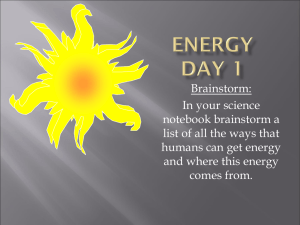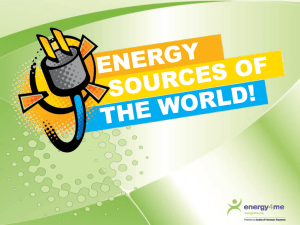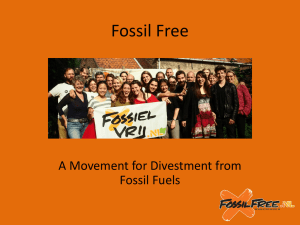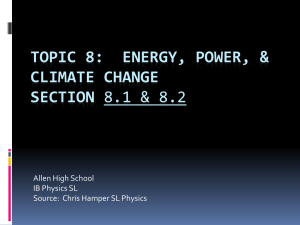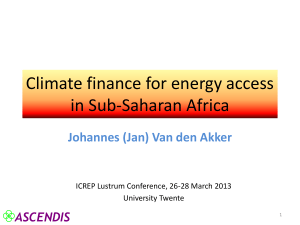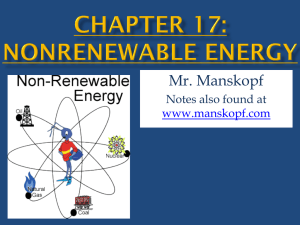Energy Resources and Fossil Fuels Hs Evs
advertisement
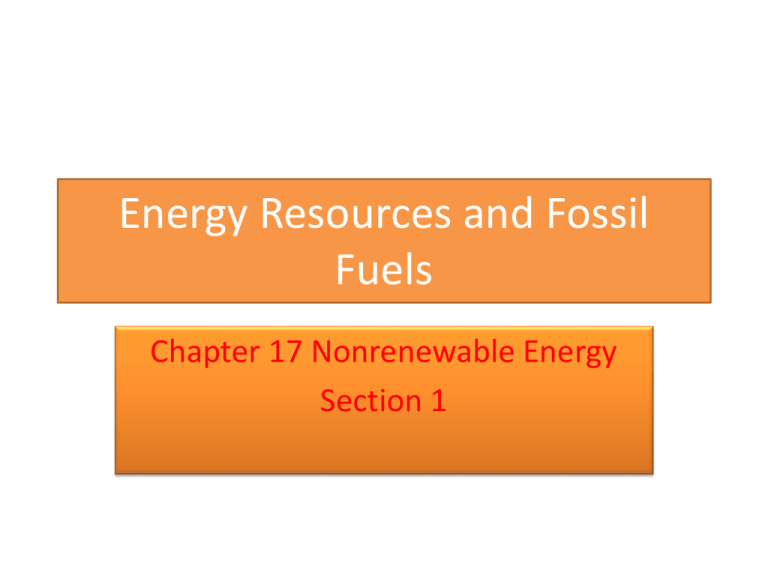
Energy Resources and Fossil Fuels Chapter 17 Nonrenewable Energy Section 1 Warm –up Video • http://www.youtube.com/watch?v=IlY7bavFb So • To be downloaded • Watch the video carefully and be ready to answer questions Enduring Understanding • Our energy consumption patterns produce a great demand for fuels in the transportation, industrial, residential, and commercial sectors. • Our choice of fuels and our dependence on them has economic, environmental, and political concsequences. Essential Questions • What makes an energy resource renewable or nonrenewable? • At what rates are the various renewable resources renewed? • Which will be the primary energy resource in the future? • What is the environmental impact of using fossil fuels? • How does the distribution of natural resources affect energy choices? Learning Objectives Students will know • To list factors that influence the value of a fuel. • To explain how fuels are used to generate electricity in an electric power plant • To identify patterns of energy consumption and production in the world and in the United States • To compare the advantages and disadvantages of fossil-fuel use • To list factors that influence production of fossilfuel production Things to Ponder • Think about how fossil fuels are involved in your daily routine and discuss with your partner how life would be different if fossil fuels resources were more limited. • You have two minutes to discuss and put your thoughts in points to be discussed with others in the class. Learning Activities Skill Practice Lab 1. Your Household Energy Consumption Conduct a survey of your household electricity consumption. Prepare a table and record information on electrical devices in your home. Learn to read your electric meter and get an electric bill to bring it to your house. Lab Worksheet to be used from Chapter Resource File 2. Worksheet based on mapskills: Fossil Fuels 3. Analyzing Energy Audit data and finding ways to improve energy efficiency that would be inexpensive but could result in significant savings. Math skills • World Energy Use In 1980, worldwide production of petroleum was 59.6 million barrels pr day. In 1998, petroleum production was 66.9 barrels a day. Calculate the percent increase in oil production during this period. Solve the problem given in the worksheet Fossil Fuels • Fossil fuels are the remains of ancient organisms that changed into coal, oil, or natural gas. • Fossil fuels are central to life in modern societies, yet there are two main problems with fossil fuels. First, the supply of fossil fuels is limited. Second, obtaining and using them has environmental consequences. Fuels for different uses • Fuels are used for four main purposes: for transportation, for manufacturing, for heating and cooling buildings, and for generating electricity to run machines and appliances. • The suitability of a fuel for each application depends on the fuel’s energy content, cost, availability, safety, and byproducts of the fuel’s use. • The value of the fuel is influenced by cost, availability, safety, energy content, and the byproducts of the fuel’s use. ELECTRICITY –POWER ON DEMAND • The energy in fuel is often converted into electrical energy in order to power machines, because electricity is more convenient to use. Electricity can be transported quickly across great distances. • Two disadvantages of electricity are that it is difficult to store and other energy sources have to be used to generate it. HOW IS ELECTRICITY GENERATED? A typical power plant converts about 33 to 40 percent of the energy contained in fossil fuels into electric energy. Does the above figure give you clues as to where the “lost” energy goes? Coal fired Power Plant • An electric generator is a machine that converts mechanical energy into electrical energy. Generators produce electrical energy by moving an electrically conductive material within a magnetic field Coal fired power plant • Most commercial electric generators convert the movement of the turbine into electric energy as shown above. • A turbine is a wheel that changes the force of a moving gas or a liquid into energy that can do work. • In most power plants, water is boiled to produce the steam that turns the turbine. Water is heated by burning a fuel in coal-fired and gas-fired plants or is hated from the fission of uranium in nuclear plants. • The turbine spins a generator to produce electricity. Energy USe • People in developed societies use much more energy than in people in developing countries do. A person in Canada and United States uses more than twice as much energy as an individual in Japan or Switzerland does. Yet personal income in Japan and Switzerland is higher than personal income in Canada and the United States. One reason for this pattern lies in how energy is generated and used in these countries. • Refer to the graph in page number 437 in your text book ENERGY USE IN THE UNITED STATES • The United States uses more energy per person than any other country in the world except Canada and the United Arab Emirates. The reason is that United States uses more than 25% of its energy resources to transport goods and people, mainly by trucks and personal vehicles. In contrast Japan and Switzerland have extensive rail systems and they are relatively small compact countries. • The availability and cost of fuel also influence fuel use. Residents of the United States and Canada enjoy some of the lowest gasoline taxes in the world. • Japan and Switzerland have minimal fossil fuel resources and supplement their energy needs with other energy sources, such as hydroelectric or nuclear power. Energy Consumption in U.S http://en.wikibooks.org/wiki/High_School_Earth_Science/Energy_Conservatio n Useful link to know energy consumption in U.S and also ways to conserve energy consumption HOW FOSSIL FUEL DEPOSITS FORM • COAL FORMATION • Coal forms from the remains of plants that lived in swamps hundreds of millions of years ago. • Oil and natural gas result from the decay of tiny marine organisms that accumulated on the bottom of the ocean millions of years ago. After these remains were buried by sediments, they were heated until they became complex energyrich carbon molecules. • Over time, these molecules migrated into the porous rock formations. Coal • Most of the world’s fossil fuel reserves are made up of coal. Asia and North America are rich in coal deposits. • Two major advantages of coal are that it is relatively inexpensive and that it needs little refining after it has been mined. • More than half of the electricity generated in the United States comes from coal-fired power plants. COAL MINING AND THE ENVIRONMENT • Surface coal mining operations sometimes remove the top of an entire mountain to reach the coal deposit. • If waste rock from coal mines is not properly contained, toxic chemicals can leach into nearby streams. • Higher grade coals, such as bituminous coal, produce more heat and less pollution than a lower-grade coal, such as lignite. • Sulfur which is found in all grades of coal, can be a major source of pollution when coal is burned. Petroleum • Oil that is pumped from the ground is also known as crude oil or petroleum. • Most of the world’s oil reserves are in the Middle East. After petroleum is removed from a well, it is transported to a refinery to be converted into fuels and other petroleum products. The environmental effects of using oil • When petroleum fuels are burned, they release pollutants. These pollutants contribute to the formation of smog and cause health problems. • Emission regulations and technology such as catalytic converters have reduced air pollution in many areas. • Oil spills, are another potential environmental problems of oil use. In recent years, new measures have been taken to prevent oil spills from tankers. These measures include requiring that new tankers be double hulled so that puncturing the outer hull does not allow the oil to leak out. Natural Gas • Natural gas can be transported in pipelines and stored in compressed tanks. Burning natural gas produces fewer pollutants than other fossil fuels. Electric power plants can also use this clean burning fuel. Fossil fuels and the future • Today, fossil fuels supply 90% of the energy used in developed countries. By 2050 world energy demand would have doubled, mainly as a result of increased population and industry in developing countries. As the demand for energy resources increases, the cost of fossil fuels will likely increase, and it will also make other source of energy attractive. • Planning now for the energy we will use in the future is important because it takes many years for a new source of energy to make a significant contribution to our energy supply. • Oil reserves are oil deposits that can be extracted profitably at current prices using current technology. Some oil deposits are yet to be discovered or to become commercial. No large oil reserves have been discovered in the past decade. Additional oil reserves are under the ocean, but extracting oil from beneath the ocean floor is much more expensive. Deepocean reserves may be tapped in the future, but unless oil-drilling technology improves, oil from the deep ocean will be much more expensive than oil produced on land. Case study: Methyl Hydrate fossil Fuel of the Future • http://www.eai.in/ref/ae/afm/afm.html • Useful link to know more about methyl hydrate • Read case study on methyl hydrate in your text book page number 440

